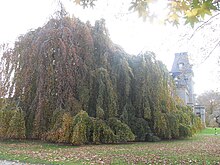Weeping beech
| Weeping Beech | |
|---|---|
 Weeping Beech, Chateau-sur-Mer, Newport, Rhode Island | |
| Species | Fagus sylvatica |
| Cultivar group | Pendula Group |
The Weeping Beech, Fagus sylvatica 'Pendula', is a cultured variety of the deciduous European Beech.
The weeping beech is characterized by its shape with sweeping, pendulous branches. The stem of the tree may not be visible from a distance due to the presence of the covering weeping branches. Branches may reach the ground and start new roots again. Smaller than the Common Beech, the tree can reach a height of up to 25 m and tends to be wider than high.[1]
Leaves of the weeping beech are broad, flat, simple and not lobed. They have smooth margins and alternate. They typically measure 5 – 10 cm in length. Flowers appear in the spring and are inconspicuous.[2] The beechnuts sit in a thin spiny husk and are less than 5 cm in diameter.[3] Young trees need to be staked to make them grow upward; growth tends to be slow. Weeping beeches may live for 150 to 200 years.
The tree is not native to North America but grows in USDA hardiness zones 4-7.[2] It needs moisture and well drained soil and prefers sunny to semi-shaded zones. The tree does not tolerate industrial pollution including street salt.

It is a spectacular tree that needs room to be fully appreciated. The green leaves become copper-toned in the fall. In winter the skeleton of the silvery stem with its branches remains attractive. The tree can be pruned for walkways.
Pest that can attack the tree includes aphids, borers (flat-headed apple tree borer, two-lined chestnut borer), certain caterpillars, and fungal disease.[2]
A fine example of Fagus sylvatica ‘Purpurea Pendula’ can be found within the Botanical Garden at Malahide Castle Nr Dublin ROI. The purple pigment in the leaves acts like a sunscreen to protect its new leaves, which is particularly important for plants that grow at high altitudes where the sun is fierce. The triangular beech nuts are popular in autumn with Malahide’s birds, mice and squirrels.
References
- ^ "Stihl Enciclopedia of Trees: Weeping Beech". Retrieved September 22, 2013.
- ^ a b c Gilman EF, Watson DG (1993). "Fagus sylvatica pendula, European Weeping Beech" (PDF). Retrieved December 1, 2009. [dead link]
- ^ Ohio Public Library Information Network. "Weeping Beech". Retrieved December 1, 2009.
